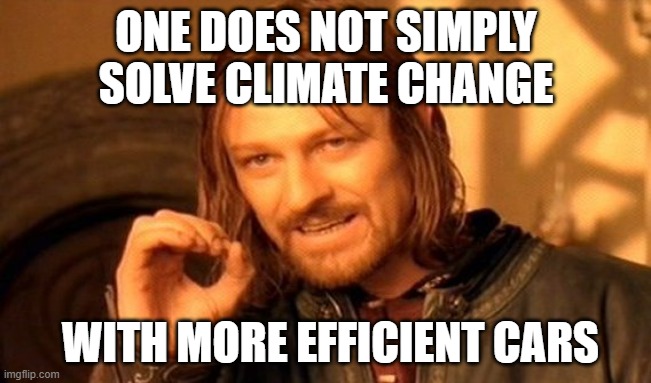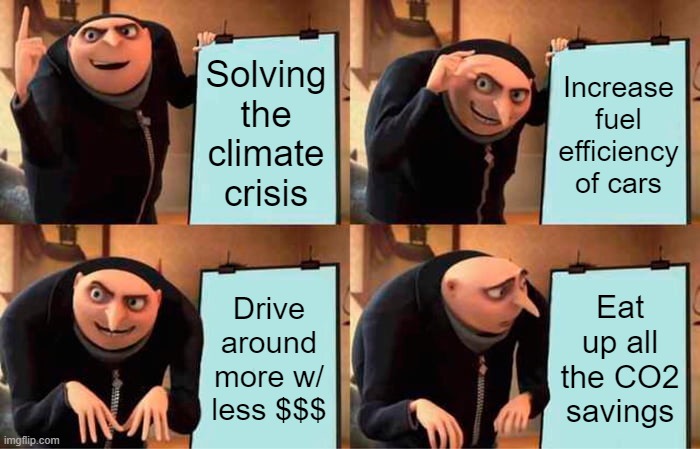Energy efficiency is no solution to climate change and in this article you will discover why. This article takes 6 minutes to read and follows a new format to give you even denser information. Let me know how you like it!
In today’s article, you will discover
- ❌ Why energy efficiency is no solution to climate change
- 🪃 What the rebound effect is and why it has everything to do with energy efficiency
- 🚀 How to get out of energy efficiency’s vicious circle
Let’s get started!
❌ Why energy efficiency is no solution to climate change
Whenever we talk about reducing greenhouse gas emissions, the topic of energy efficiency comes up as a potential solution. Whether it’s more efficient cars, more efficient planes, or more efficient oil boilers.

For decades politicians as well as industry leaders have tried to put more focus on energy efficiency as solution to reduce our CO2 emissions. However, (and yes, that’s counter-intuitive) an increase in efficiency usually does not reduce the consumption of resources. Instead, it can even drive growth of demand and consumption. This is known as the rebound effect, and it threatens to destroy a large share of our efficiency measures.
🪃 What the rebound effect is and why it has everything to do with energy efficiency
What exactly is the rebound effect? Spoiler: It has nothing to do with you getting a rebound flirt after splitting up with your ex. The rebound effect describes the fact that most energy efficiency measures save much less than they should have. And there are three components playing into this:
- Direct rebound effect
- Indirect rebound effect
- Macro-economic rebound effect
Direct rebound effect
When we use more energy efficient things, it makes it cheaper to use them. One example is a more efficient car. Imagine buying a car that uses half the fuel your former car used! That’s great, isn’t it? It saves you money on every kilometre. In fact, you can go twice as far with the same amount of money, visiting grandma more often or far away living friends – while thinking its greener because you bought a fuel-efficient car…

Same goes for the aviation sector. More fuel-efficient planes are cheaper to operate, and, therefore, lead to lower ticket prices. Due to this, people fly more frequently and longer distances. In fact, efficiency was the original enabler of the aviation sector as flying became accessible to more people with lower incomes, too.
And there are more examples:
- More efficient, but larger fridges & freezers
- Better building insulation, but higher heater temperatures for more comfort, or even an additional air conditioner
- More efficient, but larger monitors and TVs
- More efficient, but larger cars
- many more – I’m sure you can think of something
Indirect rebound effect
The thing about saving energy is of course that you also save the money that you would have spent. But if you don’t spend that money on fuel for your car anymore, you will spend it on something else.
The increased efficiency therefore leads to the production of other goods & services. It could even be invested in a nice extra holiday in the Caribbean, taking a flight which you could not have afforded if it had not been for your efficient car.
There is even a phenomenon called “moral licensing”, which describes the effect that people who do something good (drive a sustainable car) do not feel guilty for doing something bad afterwards (fly to the Caribbean). All these indirect effects eat up another chunk of our savings.
Macro-economic rebound effect
This last aspect goes a little bit beyond our personal lives. When we look at the global economy, a decrease in demand will lead to lower prices. In return, these will then inspire others to consume more, eating up a big part of the imagined savings. I have created this highly professional graphic just for you to highlight this principle.
You might remember this from school: Where supply (green) and demand (blue) meet, the consumption and the market price are set. When we now use energy efficiency to lower our demand (blue line to yellow line), this leads to decreasing prices. But with decreasing prices, demand rises again, eating up some of our efficiency savings. A new price and consumption are set at the red dot, above our expected consumption.
With all these pitfalls of the rebound effect, how do we get out of the climate crisis? How do we minimise and then stop the consumption of fossil fuels, instead of following efficiency’s vicious circle of ever more consumption and CO2 production?
🚀 How to get out of energy efficiency’s vicious circle
Luckily, there is one way out: Disruption.
And no, I’m not talking about artificial intelligence (per se). But there are innovations and solutions which disrupt the status quo. They solve the climate issues of their respective field and they do it completely without creating more savings-offsetting demand.

To identify whether a climate innovation is such a game changing disruption, you should always ask yourself these three questions:
1. Can this innovation avoid all emissions compared to the currently used solutions in the field?
Consuming fossil fuels more efficiently won’t solve the problem. It just makes it cheaper to use them, stimulating demand. Instead, we need to stop using them completely to avoid further fossil CO2 reaching the atmosphere.
2. Are there scientific or technical limitations to scaling this innovation worldwide?
An innovation can only unleash its potential if it solves the problem equally well everywhere and for everyone. If an innovation only works under extremely specific conditions, it might not be possible to deploy it at all. However, this does not mean that an innovation must solve all problems equally well. Most problems that require solving are highly specific and only affect a niche aspect of our global economy. Their solutions should be equally specific and precise in their application. This does not mean that they can’t have a strong positive impact.
3. Does this innovation have the potential to be cheaper than currently used solutions?
The second key to disruption is, always was, and always will be: economics. If an innovation is much cheaper than current solutions, it will be rapidly adopted worldwide. It took the car only a couple of years to overcome the horse carriage when it was cheaper than horses. Solar PV is now the cheapest source of electricity in the world (yes, it is) and its capacity is scaled up at an exponential rate. Just look at the historical uptake of PV capacity in the world in the next graphic. It follows a clearly exponential growth over the past 20 years. And this was before it became cheaper than coal and gas (not including storage cost). Extrapolating that trend only for a couple of years shows in which direction we are now moving. Give it 10 or 20 years, but solar PV will eat the world.
Exponential rates like this are what we need for all climate innovations. They are needed if we want them to really contribute on solving climate change. This is why bringing down cost and investing in cost reducing scale-up of production is so important. Increasing cost efficiency of disruptive sustainable alternatives is the key to solving climate change.
Whether you are an investor or an innovator, these questions are key in understanding which technologies will shape our future and solve the climate crisis.
I cover topics like these and in-depth climate innovation industries every week in my newsletter. Get direct updates on these exponentially scalable solutions which we need to really step up our game in fighting climate change. Join me and 224 innovators and entrepreneurs today at The Climate Innovator. If you enjoyed this article, spread the word, and share it with your network!
See you next week. 😉 (Haven’t subscribed to The Climate Innovator newsletter yet? Join here!)
Photo by Riccardo Annandale on Unsplash





